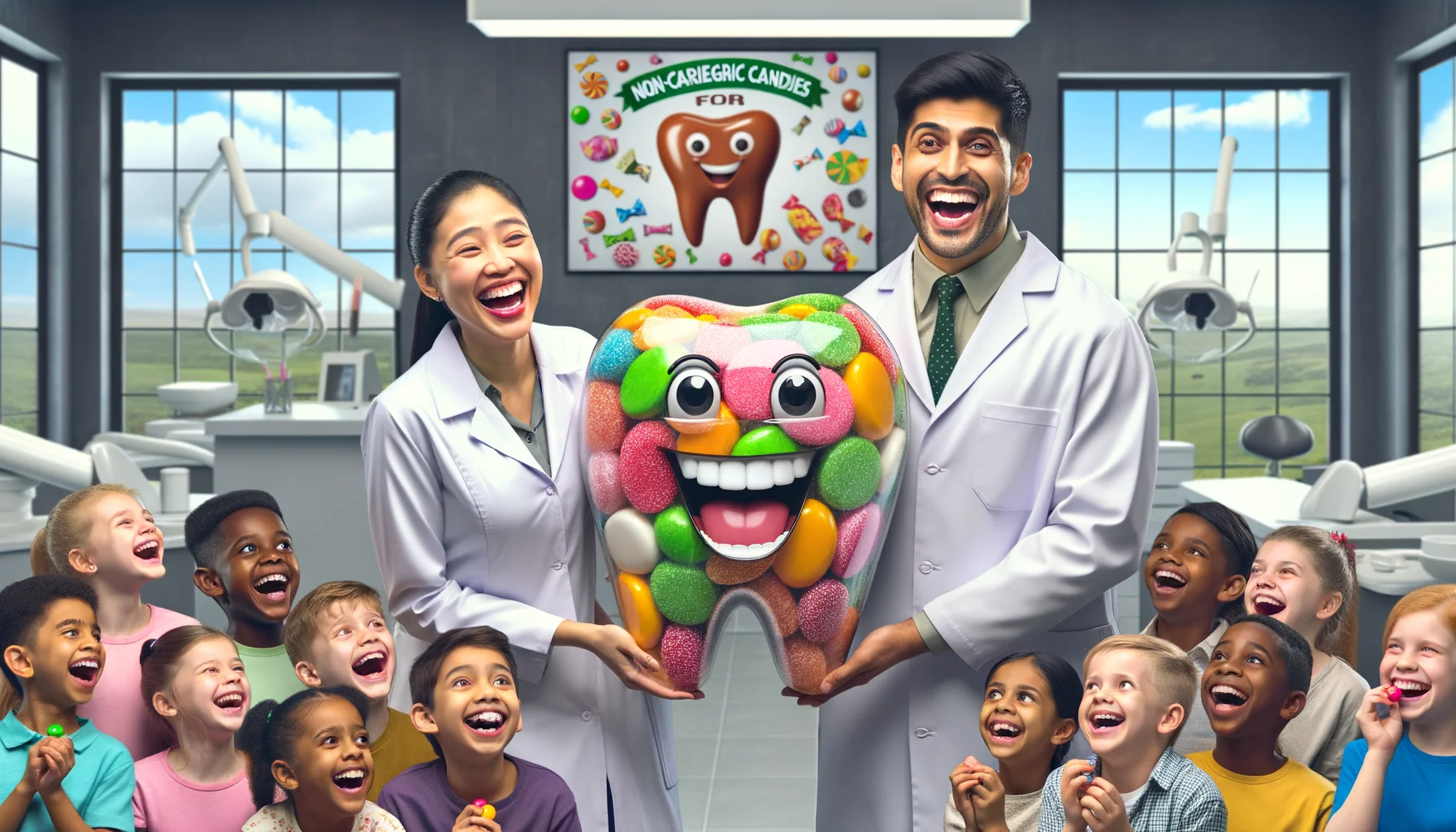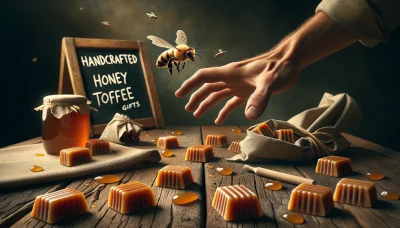Non-Cariogenic Candies for Dental Health Quiz
Test Your Knowledge
Question of
Understanding Non-Cariogenic Candies
Definition and Benefits
Ah, the sweet symphony of indulging in candies, that delightful interlude where we allow ourselves a moment of pure, sugary bliss. However, nestled within this melody of sweetness often lies a discordant note the threat to our dental health. Enter the harmonious alternative: non-cariogenic candies. These treats are like the unsung heroes of the confectionery world, offering us the joy of snacking without the usual dental distress.
So what are non-cariogenic candies? Picture this: a candy that doesn't play into the notorious schemes of tooth decay. These sweets don't ferment in your mouth to form acids and therefore, they don't contribute to cavity formation. They come with a badge of honor for being kind to your teeth while still satisfying your sweet tooth. It's like discovering that your favorite comfort snack has had a secret superhero identity all along!
Comparing to Traditional Sugary Sweets
Traditional sugary sweets are akin to a thrilling roller coaster ride for our teeth ups and downs filled with exhilarating sweetness followed by the plunge into potential cavities. These candies are often loaded with sucrose and fructose which can be harmful to enamel over time. On the flip side, non-cariogenic candies are like a leisurely stroll through a park on a sunny day; they offer enjoyment without any unexpected drops.
The benefits of choosing non-cariogenic candies over traditional sweets are as clear as the difference between night and day. While both can tickle your taste buds, only one leaves behind an aftertaste of guilt-free pleasure and peace of mind about your dental health.
Ingredients to Look For
When embarking on this tooth-friendly journey, it's essential to know what ingredients to scout for. Think of it as going on a treasure hunt where X marks the spot for natural sweeteners that won't betray your pearly whites.
- Natural Sweeteners Used: Look out for natural sweeteners such as Stevia or xylitol these are like finding gems among stones in terms of dental health.
- Role of Sugar Alcohols: Sugar alcohols such as erythritol or sorbitol are also allies in this quest; they have the sweetness you crave but lack the harmful effects on your teeth.
- Importance of pH Levels in Candies: Lastly, ensure that these treats have a neutral pH level acidic environments in your mouth are playgrounds for cavities, so maintaining balance is key.
Embracing non-cariogenic candies means you're not just choosing sweets; you're choosing a path that leads towards better oral health without sacrificing flavor. It's an adventure where every bite is infused with carefree delight and none of the worry.
The Impact of Sugar on Teeth
Oh, the sweet symphony of a sugar rush! As delightful as it is to let a piece of candy melt in your mouth, there's an unseen battle raging in the depths of our teeth. Each sugary treat can be like a siren call to the tiny troublemakers waiting to wreak havoc on our pearly whites. You see, sugar and teeth have this love-hate relationship. We adore the taste, but our teeth? Not so much.
How Sugar Causes Tooth Decay
It's a tale as old as timeor at least as old as dentistry. You pop a sweet morsel into your mouth, and while you're savoring that blissful flavor, sugar is cozying up to your teeth in all the wrong ways. But how does this seemingly innocent indulgence translate into a toothache-inducing nightmare? Let's peel back the layers of this confectionery onion.
The Process of Enamel Erosion
Imagine your tooth enamel as an invincible shieldwell, almost invincible. When sugar enters the scene, it's like sending out an RSVP to bacteria for a party on your enamel. The bacteria feed on sugar and produce acids that slowly but surely erode this protective layer. It's akin to watching your favorite fortress under siege by an army of tiny acid-throwing catapults.
Role of Bacteria in Cavity Formation
Bacteria are the uninvited guests who love to crash the party. They thrive on sugar, multiplying with glee and producing even more acid in the process. This relentless acid attack weakens the tooth structure, leading to those pesky holes we know as cavities. Its not exactly what you signed up for when you reached for that scrumptious candy bar, right?
Sugar's Effect on Oral pH Balance
The mouths pH balance is like a finely tuned ecosystemdisrupt it, and chaos ensues. When sugar enters the mix, it tips the scales toward acidity, creating an environment where harmful bacteria can flourish. This acidic setting accelerates enamel degradation and sets the stage for decay. And before you know it, your sweet escape becomes a sour experience for your chompers.
Benefits of Reducing Sugar Intake
Laying off the sweets may sound like a joyless endeavor, but trust me; your future self will thank you for it. Reducing sugar intake isn't just about avoiding cavities; it's about embracing a lifestyle change that could lead to some sparkling results for both your dental and overall health.
Long-Term Dental Health Advantages
Less sugar means fewer bacteria parties and more reasons for your enamel to celebrate its resilience. Over time, minimizing those sugary snacks could mean fewer trips to the dentist and more money in your pocketnot to mention the pride that comes from sporting a cavity-free smile at any age.
Preventing Cavities and Tooth Decay
Cut down on sugar, and watch as your risk for cavities plummets like a superhero swooping in to save the day. It's not just about dodging dental procedures; it's about keeping every tooth intact and avoiding that dreaded drilla heros journey for oral preservation!
Overall Health Improvements
- Better Nutrition: When you cut down on sugary sweets, theres more room in your diet for nutrient-rich foods that don't just dance around with bacteriathey nourish every corner of your being.
- Increased Energy: Ever experienced that post-sugar crash? Reducing sugar can help maintain steady energy levels throughout the day without those dramatic highs and lows.
- Glycemic Control: For those keeping an eye on blood sugar levels, reducing intake can lead to better glycemic controla sweet victory indeed!
Alternatives to Sugary Treats
Oh, the siren call of sugary temptations, how it beckons with a sweet whisper that's hard to resist! But nestled within my journey towards healthier living, I've discovered treasures that appease the sweet tooth without the guilt - yes, the world of non-cariogenic candies and snacks. These delightful alternatives have been a game-changer for me, allowing indulgence without compromising my dental health.
I remember the first time I swapped out my usual sugar-laden candy for a fruit-based option. It was like a revelation; the burst of natural sweetness from dried mangoes and freeze-dried strawberries danced on my tongue. The textures were a joyous celebration - chewy, yet tender - and they held within them the promise of a cavity-free smile. It was an epiphany that one could still revel in the rapture of sweets without courting cavities as an inevitable suitor.
Healthy Snack Options
The array of healthy snack options available today is nothing short of astonishing. It's as if every flavor profile has been meticulously crafted to ensure we're not left wanting. From tangy to sweet, there's a virtuous choice for every palate. Fruit-based candies are my go-to when I'm looking for something naturally sweet and satisfying. The essence of real fruit, concentrated into bite-sized pieces, offers an authentic taste experience that's both gratifying and wholesome.
But why stop at fruit when dairy-based snacks beckon with their creamy allure? Yogurt-covered raisins and cheese cubes have become staples in my snacking arsenal. They provide that comforting creaminess that often accompanies traditional sweets but come with beneficial nutrients like calcium and protein. And let's not forget about nut and seed bars compact powerhouses of flavor and nutrition that deliver a satisfying crunch along with heart-healthy fats.
- Fruit-Based Candies: A rainbow of flavors derived from nature's own candy - fruits.
- Dairy-Based Snacks: Indulge in the rich textures and tastes while feeding your bones with calcium.
- Nut and Seed Bars: Embrace the crunch and savor the sustaining energy these little gems provide.
Incorporating Non-Cariogenic Candies in Diet
Now, balancing taste with health doesn't have to be akin to walking a tightrope. It can be as simple as choosing non-cariogenic candies over their sugar-laden counterparts. These tooth-friendly treats are crafted to minimize the risk of cavities, thanks to sugar substitutes like xylitol and erythritol that don't feed those pesky oral bacteria. The magic lies in finding those products that strike a perfect harmony between enticing your taste buds and keeping your pearly whites safe.
Snacking without guilt has become my new mantra since embracing non-cariogenic candies. I recall sitting at work post-lunch, battling the infamous afternoon slump when I reached for a piece of sugar-free chocolate. As it melted luxuriously on my tongue, I grinned inwardly knowing I had outwitted any potential dental distress while still satisfying my craving for something sweet. It felt liberating like having your cake and eating it too!
Creative ways to satisfy sweet cravings can be quite the adventure! Sometimes I find myself experimenting with homemade recipes; other times I indulge in commercially available non-cariogenic confections. From making smoothies with a dash of stevia to freezing Greek yogurt mixed with fresh berries, these alternatives are not just about avoiding sugar they're about discovering new tastes and textures that bring joy to every nibble.
The Role of Xylitol in Dental Health
There's something about the word "candy" that conjures up memories of sticky hands and sweet tongues, but when it comes to xylitol, the narrative takes an unexpected turn. You see, my journey with xylitol began on a dentist's chair, of all places. I was there, mouth agape, listening to a sermon on cavities when xylitol swept in like a dental superhero. It was as if my taste buds and teeth finally found common ground.
Imagine my surprise when I learned that this magic ingredient not only tasted like the naughty sugar we all adore but also played for team enamel. It was like discovering your favorite guilty pleasure had a hidden talent for boosting your health. And so, down the rabbit hole of dental well-being I tumbled, with xylitol lighting the way.
Now, let's peel back the layers of this sweet paradox together and explore how xylitol is changing the game for candy lovers who hold their breath every time they visit the dentist.
Understanding Xylitol and Its Properties
What is Xylitol?
The first time I heard about xylitol, I thought it sounded like something out of a sci-fi novel "Xylitol: The Sweetener from Outer Space!" But in truth, it's far more down-to-earth. Extracted from birch trees and other woody plants, xylitol saunters into your life offering a low-calorie alternative to sugar with a side dish of health benefits.
It's a natural sweetener that seems too good to be true kind of like finding an extra piece of your favorite chocolate tucked away in a forgotten pocket. But xylitol is real alright, and its tooth-friendly reputation precedes it.
So let's take a moment to tip our hats to Mother Nature for this one; she really outdid herself by crafting something that can make both dentists and sweet tooths beam with joy.
Xylitol's Unique Dental Benefits
Here's where things get interesting: unlike its sugary cousins that love to throw parties for bacteria in your mouth (cavity central), xylitol isn't just neutral; it's downright hostile to those tiny enamel munchers. When I discovered that consuming xylitol could actually reduce plaque formation and tooth decay, I felt like I'd been handed a secret weapon one that tastes suspiciously like victory.
Every time I pop a piece of xylitol gum or savor a mint, there's this little smirk that plays on my lips because I know I'm outwitting those cavity-causing critters. It feels less like eating candy and more like engaging in some sort of delicious espionage against dental villains.
And while we're celebrating this marvel, let's not forget how it manages to maintain pH levels in our mouths. Its almost as if xylitol knows just how to charm our oral environment into staying just right not too acidic, not too basic. Just perfect.
The Science Behind Xylitol and Oral Health
Now lets talk science don't worry; its the fun kind! Xylitol has this knack for tricking bacteria into thinking its glucose. But heres the catch: they cant metabolize it. Imagine inviting someone to dinner only to serve them an empty plate; thats basically what xylitol does to harmful oral bacteria.
And there's more studies have shown that regular use of xylitol can actually help repair damaged enamel. Yes, you read that right repair! That means every time you choose a xylitol-sweetened treat over traditional sugar-laden options; you're basically giving your teeth mini spa treatments.
So while we indulge in these treats with their minty freshness or sugary allure, we're also participating in cutting-edge dental care without even trying. How about that for multitasking?
Xylitol-Infused Candy Options
Chewing Gums and Mints
Chewing gum is my discreet daily indulgence its like whispering sweet nothings to my molars while freshening my breath at the same time. My favorite part? Discovering gums laden with xylitol instead of sugar was akin to unearthing treasure on an ordinary day.
And mints! Oh, those little bursts of coolness that save us from dreaded coffee breath or the aftermath of garlic bread bliss they now come bearing gifts of dental health thanks to their pal xylitol. Who knew fresh breath could be so responsible?
- Revolutionary Breath Fresheners: With flavors ranging from peppermint icebergs to tropical breezes.
- Guilt-Free Glee: Chew away without any fear of cavities lurking around the corner.
- Portable Smile Support: A pocket-sized ally always ready to jump into action after every meal.
Chocolate and Hard Candies
Now let us not forget about chocolate and hard candies they've been there for us through breakups, movie nights, and everything in between. But imagine if these comforting companions came infused with tooth-friendly powers? Thats where xylitol-infused chocolates enter stage left with a flourish.
They melt on your tongue with all the richness you crave but without leaving behind regret or plaque buildup. Its almost as if youve been given permission to indulge guilt-free which is precisely what were all yearning for deep down inside, isn't it?
Xylitol Syrups and Spreads
Lastly, let me introduce you to syrups and spreads because why should candies have all the fun? Drizzle some xylitolic joy over pancakes or spread it on toast for an innocently indulgent start to your day.
Dental-Friendly Candy Brands and Products
There's a sweet symphony that plays in my mouth whenever I indulge in candies. Yet, there's always been that pang of guilt with every sugary note, knowing that my teeth might be paying the price. But what if I told you that there are certain brands out there playing a different tune? Yes, dental-friendly candy brands have become my solace, the harmonious middle ground where pleasure meets prudence.
It's like discovering a secret garden where every blossom is a tooth-friendly treat. These brands have carefully crafted their confections to ensure that our smiles stay as bright as the twinkle in our eyes when we savor these sweets. It's a game-changer the guilt has been lifted, replaced by the joy of responsible indulgence.
The world of non-cariogenic candies is like an unexplored realm filled with treasures for both our taste buds and teeth. The magic lies in their ability to provide us with the joy of snacking without the fear of cavities lurking around the corner. It's almost too good to be true, but it's not; it's just science sweetly embraced by smart confectionery.
Recommended Brands for Healthy Teeth
When I first ventured into the realm of tooth-friendly candies, I felt like an explorer setting foot on an unknown island. The array of brands promising a guilt-free experience was overwhelming, yet tantalizing. It was a delightful dilemma to be in choosing which treasure trove to dive into first.
Leading Non-Cariogenic Candy Brands
I've found myself drawn to certain brands that stand out not just for their delectable offerings, but also for their commitment to dental health. These are the pioneers who understood that our cravings need not come at a cost to our pearly whites. They use alternative sweeteners like xylitol and erythritol which are kinder to our teeth, turning each candy from a guilty pleasure into a gleeful delight.
Product Lines Focused on Dental Health
Among these brands are those who have dedicated entire product lines to ensuring our dental well-being. They craft gummies, lollipops, and even chocolate bars that are allies in our quest for oral health. Each bite is infused with ingredients that neutralize pH levels or rebuild enamel, making snacking an act of care rather than concern.
Customer Reviews and Testimonials
The testimonials speak volumes tales of children enjoying sweets without admonishment from dentists, or adults indulging in midnight cravings without subsequent remorse. The reviews paint pictures of improved dental check-ups and liberated sweet tooths, all singing praises for these innovative treats.
Evaluating Product Quality and Effectiveness
I learned quickly that not all candies labeled "dental-friendly" are created equal. It became my mission to discern which treats could truly be trusted as allies in my dental health crusade. This meant delving deeper into what makes these candies tick or should I say click with my teeth?
Analyzing Ingredients and Nutritional Information
The list of ingredients became my map guiding me through forests of sweeteners and over mountains of additives. I learned to identify those components that were kind to teeth: natural flavors, plant-based colors, and sugar alcohols like xylitol which wage war against harmful bacteria without inciting cavities' wrath.
- Xylitol: A champion in reducing tooth decay.
- Erythritol: Known for its plaque-fighting prowess.
- Stevia: Sweetening the deal without feeding the cavity culprits.
Understanding ADA Seal of Acceptance
Beyond ingredients lies another beacon of trustworthiness the ADA Seal of Acceptance. This seal is like a knights shield bearing the emblem of dental defense; it signifies products meeting strict criteria set by oral health experts. When I see it on packaging, it's as though I hear trumpets announcing I've made a wise choice for my chompers.
Real-World Impact on Dental Check-Ups
The proof, they say, is in the pudding or in this case, perhaps the proof is in the sugar-free pudding! My own experiences mirror those sung by voices across countless reviews: fewer cavities, less plaque buildup, and brighter smiles between dental visits. It's evidence that resonates more than any claim or statistic ever could real-world impact you can see right there in your own reflection.
Tips for Maintaining Oral Hygiene with Candies
Ah, candies. Those little morsels of joy that can send us on a sugar high and, if we're not careful, a guilt trip straight to the dentist's chair. But what if I told you that indulging in your sweet tooth doesn't have to be a dental debacle? It's all about embracing non-cariogenic candiesthose tooth-friendly treats that won't turn your pearly whites into a cavity carnival.
The conundrum of candy consumption is as old as timeor at least as old as dentistry. But fret not, for I have journeyed through the sugary trenches and emerged with wisdom to share. So buckle up, sweet aficionados, and prepare for some enlightening tips on maintaining oral hygiene without giving up the confectionery delights.
First things first, let's talk about strategy. You see, it's not just what you eat but how and when you eat it that can make all the difference. Let's dive into some best practices for candy consumption that will keep both your taste buds and teeth in harmony.
Best Practices for Candy Consumption
When it comes to enjoying candies without inviting cavities to the party, timing is everything. You might be surprised to learn that there are strategic moments for sneaking in a sweet treat that can minimize the risk of tooth decay.
For instance, did you know that savoring a piece of candy during or shortly after meals can be less harmful? That's right! Meals tend to increase saliva production which can help neutralize acids produced by bacteria in your mouth and rinse away food particles.
- Timing and Frequency of Eating Candies: Aim to limit candy intake to mealtimes rather than between meals when saliva flow decreases.
- Pairing with Other Foods for Oral Balance: Combining candies with foods that are rich in calcium and phosphorus can help protect tooth enamel.
- Drinking Water to Enhance Dental Care: Following up your confectionery escapades with water helps wash away sugars and acids.
Oral Care Routines with Non-Cariogenic Candies
Non-cariogenic candies are like the superheroes of the candy worldthey swoop in with their sugar-free capes and save the day (and your teeth). These treats typically contain alternative sweeteners like xylitol or erythritol which bacteria in your mouth find rather unappetizing.
Now, integrating these dental-friendly delights into your daily routine doesn't mean you can skip out on brushing or flossingthink of them as allies rather than replacements. Here are some post-candy teeth cleaning tips because even superheroes need backup sometimes:
- Integrating into Daily Dental Hygiene: Choose non-cariogenic candies as part of your snack rotation and maintain regular brushing and flossing habits.
- Post-Candy Teeth Cleaning Tips: After indulging, wait 30 minutes before brushingthat's when enamel is most sensitive due to acid exposure.
- Regular Dental Visits and Professional Advice: Keep up with dental check-ups so your dentist can provide personalized advice for your sweet-eating habits.
Educating Children on Sweet Choices and Dental Health
Making Dental Health Fun for Kids
There's a certain kind of magic in the way kids light up at the mention of sweets. Their eyes twinkle, mirroring the glossy sheen of a lollipop or the sparkle of sugary sprinkles on a cupcake. But as we navigate the path between delight and dental health, it becomes essential to sprinkle a bit of that magic onto non-cariogenic candiesthe unsung heroes in the land of treats. Making dental health fun for kids is like turning toothbrush time into an adventure, where every plaque-fighting session is a quest, and each fluoride rinse is a potion for strengthening their tiny pearly whites.
Interactive learning activities about sugar and teeth can be as joyful as a game of hopscotch on a sunny afternoon. Imagine transforming the concept of cavities into an engaging story where sugar bugs are villains, and brushing is the child's superpower. And when it comes to rewards, who says they can't be tooth-friendly? Kid-friendly non-cariogenic candy options serve as excellent treasures at the end of their daily quests. These treats come in all shapes and sizes from zesty fruit chews that dance on the tongue to minty chocolates that whisper sweet nothings to their taste buds without whispering decay to their teeth.
Reward systems that promote good dental habits can be as simple as sticker charts or as elaborate as a treasure chest filled with sugar-free goodies. Each victorious day without sugary snacks earns them a star, leading to a grand prize that doesn't compromise their shining smiles. It's about finding joy in the crunch of an xylitol-sweetened cookie or the smooth dissolve of a maltitol-laced hard candypleasures that are sweet but kinder to tiny teeth.
Involving Kids in Healthy Decision Making
Every trip down the grocery aisle can be a scavenger hunt when you're involving kids in healthy decision-making. Their little fingers point at colorful packages, and here lies our chance to teach them about ingredients and labels. "See this long word here? It's called xylitolit's like sugar's cousin who loves teeth!" These moments are opportunities to empower them with knowledge, transforming them into wise consumers who can look beyond flashy packaging and cute mascots.
Encouraging self-care routines extends beyond just brushing and flossingit's about nurturing a mindset where they understand that what goes into their bodies can affect their smiles too. Its about swapping bedtime stories for discussions on how certain candies can be friends with their teeth, creating routines where they reach for a piece of cheese after meals because they know it helps neutralize acids produced by bacteria in plaque.
- Setting an example with healthy snacking choices is crucial; after all, little eyes are always watching.
- When they see us savoring sugar-free gum instead of sticky caramels or relishing in dark chocolate over milk chocolate laden with sugars, we become living lessons in indulgence without compromise.
- Treats don't have to be taboo; they just need to be thoughtfullike choosing confections made with erythritol or stevia that satisfy sweet cravings while laughing in the face of cavities.
The journey towards embracing non-cariogenic candies isn't just about preserving dental healthit's about crafting memories woven with laughter and learning, where every treat is also a teaching moment. Its about showing our kids that taking care of themselves can be deliciously rewardingand isnt that just the sweetest lesson of all?











